HA2032 - Financial Accounting: Disclosure Regulation & Analysis
VerifiedAdded on 2023/06/04
|13
|2653
|327
Report
AI Summary
This report provides an analysis of corporate and financial accounting practices, focusing on disclosure regulations. It discusses whether financial accounting and reporting should be regulated or if managers should be allowed to disclose information voluntarily. The report also covers accounting standard setting, specifically AASB and IFRS, and examines the components of owner's equity, including contributed capital, reserves, and retained earnings. The analysis includes a review of the debt and equity components of four listed companies: BHP Billiton, Orica Limited, Rio Tinto, and Fortescue, evaluating their debt-equity ratios and overall financial health. The report concludes with insights into the importance of balanced financial structures and the impact of debt levels on company operations.
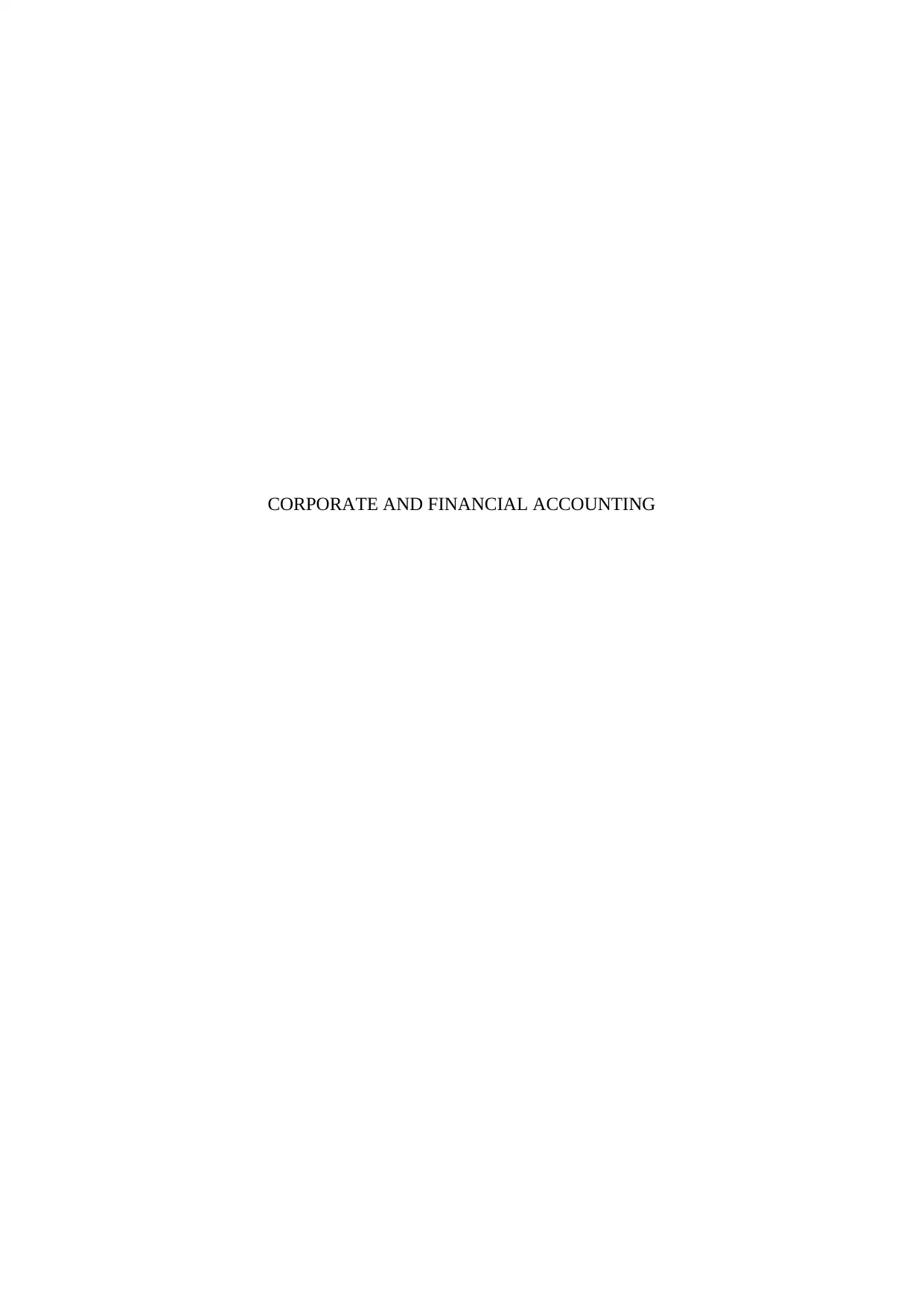
CORPORATE AND FINANCIAL ACCOUNTING
Paraphrase This Document
Need a fresh take? Get an instant paraphrase of this document with our AI Paraphraser
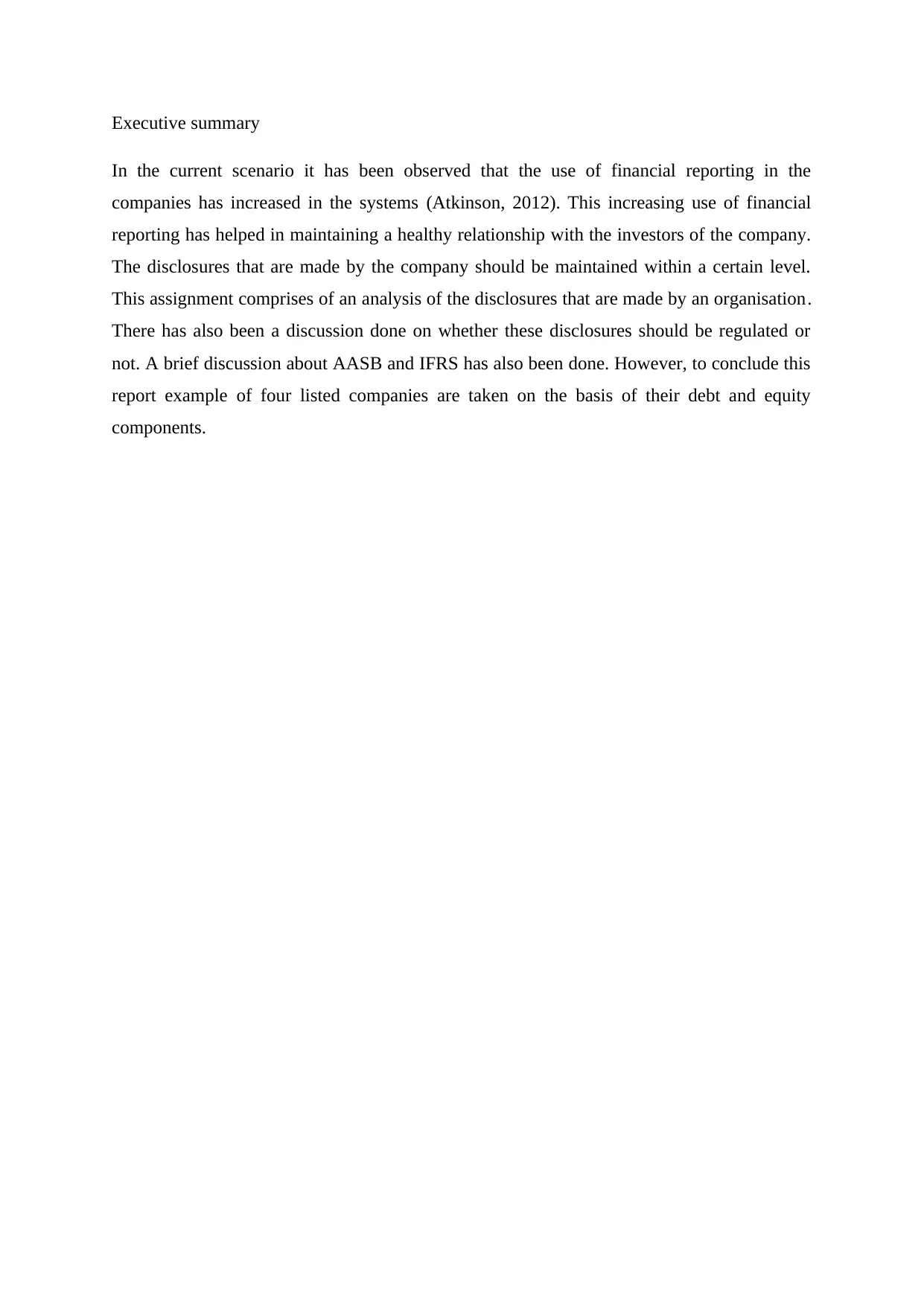
Executive summary
In the current scenario it has been observed that the use of financial reporting in the
companies has increased in the systems (Atkinson, 2012). This increasing use of financial
reporting has helped in maintaining a healthy relationship with the investors of the company.
The disclosures that are made by the company should be maintained within a certain level.
This assignment comprises of an analysis of the disclosures that are made by an organisation.
There has also been a discussion done on whether these disclosures should be regulated or
not. A brief discussion about AASB and IFRS has also been done. However, to conclude this
report example of four listed companies are taken on the basis of their debt and equity
components.
In the current scenario it has been observed that the use of financial reporting in the
companies has increased in the systems (Atkinson, 2012). This increasing use of financial
reporting has helped in maintaining a healthy relationship with the investors of the company.
The disclosures that are made by the company should be maintained within a certain level.
This assignment comprises of an analysis of the disclosures that are made by an organisation.
There has also been a discussion done on whether these disclosures should be regulated or
not. A brief discussion about AASB and IFRS has also been done. However, to conclude this
report example of four listed companies are taken on the basis of their debt and equity
components.
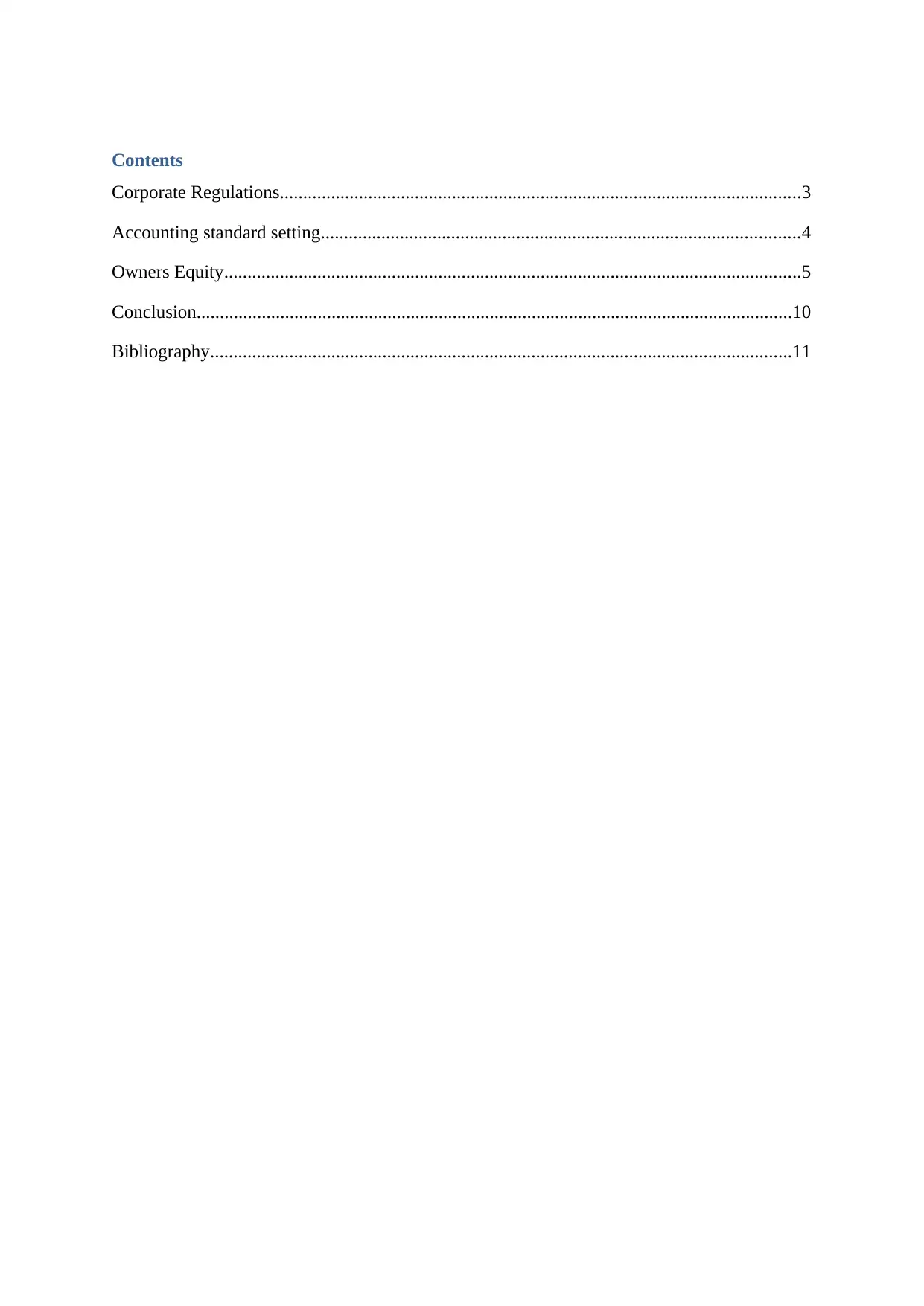
Contents
Corporate Regulations................................................................................................................3
Accounting standard setting.......................................................................................................4
Owners Equity............................................................................................................................5
Conclusion................................................................................................................................10
Bibliography.............................................................................................................................11
Corporate Regulations................................................................................................................3
Accounting standard setting.......................................................................................................4
Owners Equity............................................................................................................................5
Conclusion................................................................................................................................10
Bibliography.............................................................................................................................11
⊘ This is a preview!⊘
Do you want full access?
Subscribe today to unlock all pages.

Trusted by 1+ million students worldwide
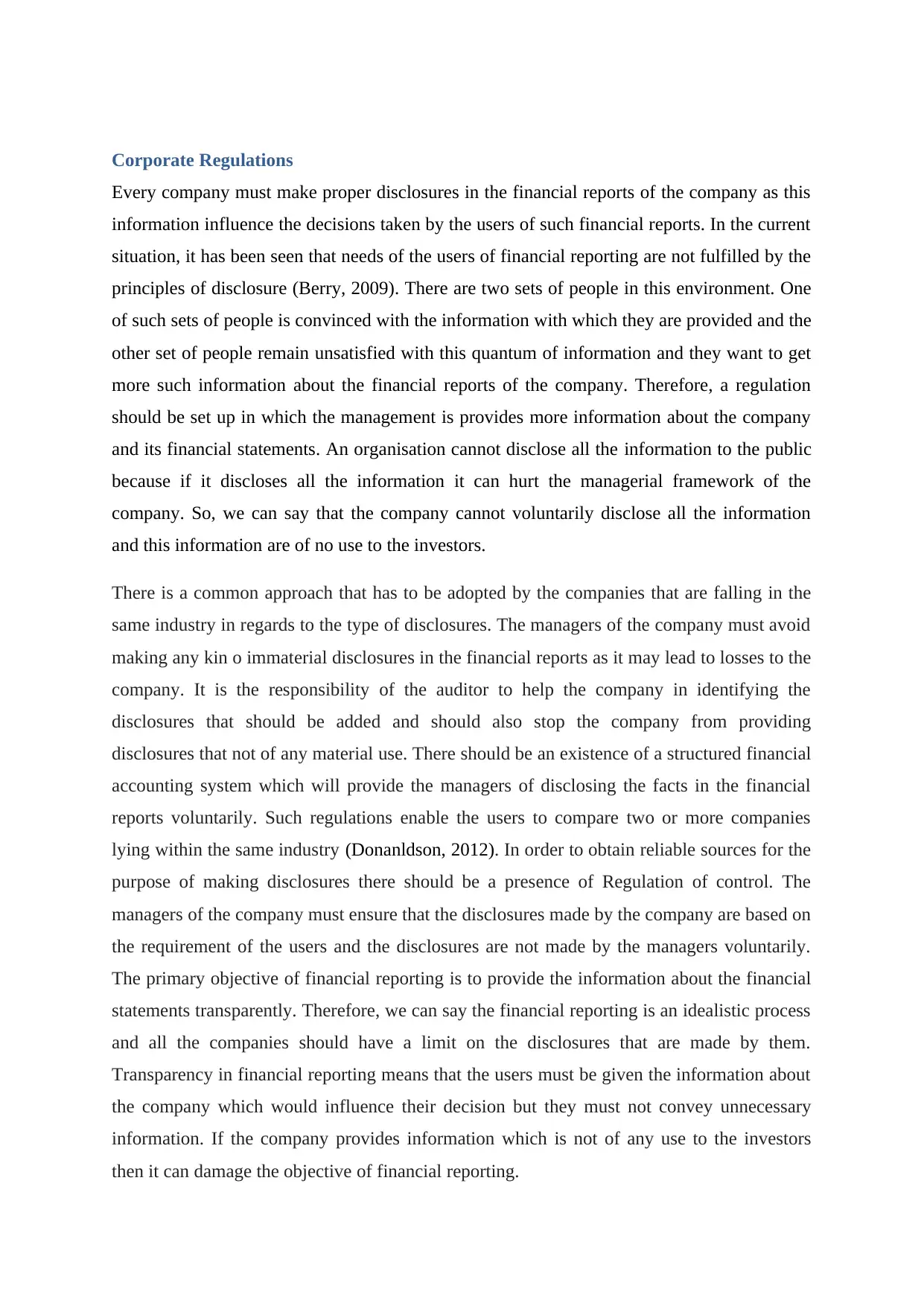
Corporate Regulations
Every company must make proper disclosures in the financial reports of the company as this
information influence the decisions taken by the users of such financial reports. In the current
situation, it has been seen that needs of the users of financial reporting are not fulfilled by the
principles of disclosure (Berry, 2009). There are two sets of people in this environment. One
of such sets of people is convinced with the information with which they are provided and the
other set of people remain unsatisfied with this quantum of information and they want to get
more such information about the financial reports of the company. Therefore, a regulation
should be set up in which the management is provides more information about the company
and its financial statements. An organisation cannot disclose all the information to the public
because if it discloses all the information it can hurt the managerial framework of the
company. So, we can say that the company cannot voluntarily disclose all the information
and this information are of no use to the investors.
There is a common approach that has to be adopted by the companies that are falling in the
same industry in regards to the type of disclosures. The managers of the company must avoid
making any kin o immaterial disclosures in the financial reports as it may lead to losses to the
company. It is the responsibility of the auditor to help the company in identifying the
disclosures that should be added and should also stop the company from providing
disclosures that not of any material use. There should be an existence of a structured financial
accounting system which will provide the managers of disclosing the facts in the financial
reports voluntarily. Such regulations enable the users to compare two or more companies
lying within the same industry (Donanldson, 2012). In order to obtain reliable sources for the
purpose of making disclosures there should be a presence of Regulation of control. The
managers of the company must ensure that the disclosures made by the company are based on
the requirement of the users and the disclosures are not made by the managers voluntarily.
The primary objective of financial reporting is to provide the information about the financial
statements transparently. Therefore, we can say the financial reporting is an idealistic process
and all the companies should have a limit on the disclosures that are made by them.
Transparency in financial reporting means that the users must be given the information about
the company which would influence their decision but they must not convey unnecessary
information. If the company provides information which is not of any use to the investors
then it can damage the objective of financial reporting.
Every company must make proper disclosures in the financial reports of the company as this
information influence the decisions taken by the users of such financial reports. In the current
situation, it has been seen that needs of the users of financial reporting are not fulfilled by the
principles of disclosure (Berry, 2009). There are two sets of people in this environment. One
of such sets of people is convinced with the information with which they are provided and the
other set of people remain unsatisfied with this quantum of information and they want to get
more such information about the financial reports of the company. Therefore, a regulation
should be set up in which the management is provides more information about the company
and its financial statements. An organisation cannot disclose all the information to the public
because if it discloses all the information it can hurt the managerial framework of the
company. So, we can say that the company cannot voluntarily disclose all the information
and this information are of no use to the investors.
There is a common approach that has to be adopted by the companies that are falling in the
same industry in regards to the type of disclosures. The managers of the company must avoid
making any kin o immaterial disclosures in the financial reports as it may lead to losses to the
company. It is the responsibility of the auditor to help the company in identifying the
disclosures that should be added and should also stop the company from providing
disclosures that not of any material use. There should be an existence of a structured financial
accounting system which will provide the managers of disclosing the facts in the financial
reports voluntarily. Such regulations enable the users to compare two or more companies
lying within the same industry (Donanldson, 2012). In order to obtain reliable sources for the
purpose of making disclosures there should be a presence of Regulation of control. The
managers of the company must ensure that the disclosures made by the company are based on
the requirement of the users and the disclosures are not made by the managers voluntarily.
The primary objective of financial reporting is to provide the information about the financial
statements transparently. Therefore, we can say the financial reporting is an idealistic process
and all the companies should have a limit on the disclosures that are made by them.
Transparency in financial reporting means that the users must be given the information about
the company which would influence their decision but they must not convey unnecessary
information. If the company provides information which is not of any use to the investors
then it can damage the objective of financial reporting.
Paraphrase This Document
Need a fresh take? Get an instant paraphrase of this document with our AI Paraphraser
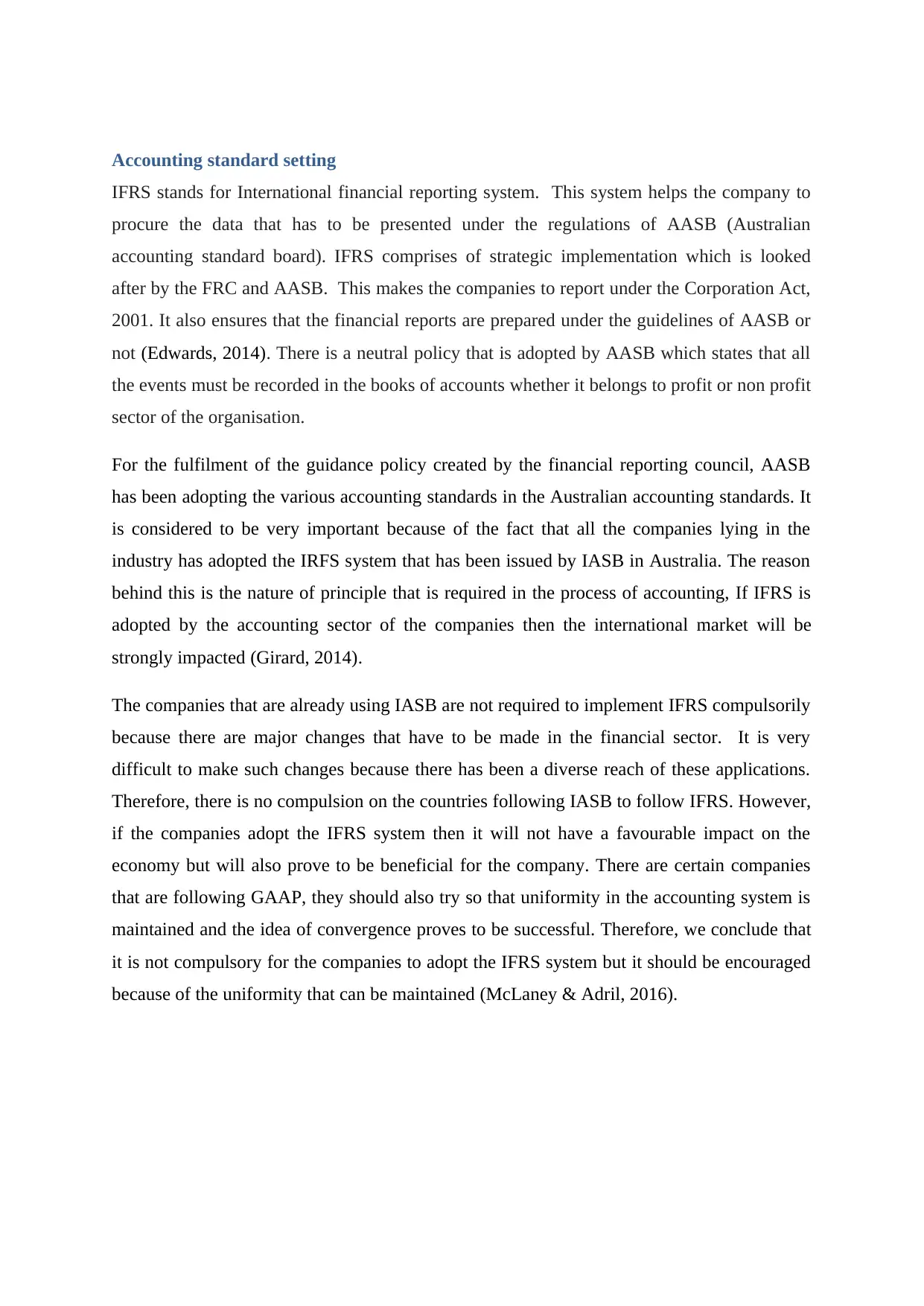
Accounting standard setting
IFRS stands for International financial reporting system. This system helps the company to
procure the data that has to be presented under the regulations of AASB (Australian
accounting standard board). IFRS comprises of strategic implementation which is looked
after by the FRC and AASB. This makes the companies to report under the Corporation Act,
2001. It also ensures that the financial reports are prepared under the guidelines of AASB or
not (Edwards, 2014). There is a neutral policy that is adopted by AASB which states that all
the events must be recorded in the books of accounts whether it belongs to profit or non profit
sector of the organisation.
For the fulfilment of the guidance policy created by the financial reporting council, AASB
has been adopting the various accounting standards in the Australian accounting standards. It
is considered to be very important because of the fact that all the companies lying in the
industry has adopted the IRFS system that has been issued by IASB in Australia. The reason
behind this is the nature of principle that is required in the process of accounting, If IFRS is
adopted by the accounting sector of the companies then the international market will be
strongly impacted (Girard, 2014).
The companies that are already using IASB are not required to implement IFRS compulsorily
because there are major changes that have to be made in the financial sector. It is very
difficult to make such changes because there has been a diverse reach of these applications.
Therefore, there is no compulsion on the countries following IASB to follow IFRS. However,
if the companies adopt the IFRS system then it will not have a favourable impact on the
economy but will also prove to be beneficial for the company. There are certain companies
that are following GAAP, they should also try so that uniformity in the accounting system is
maintained and the idea of convergence proves to be successful. Therefore, we conclude that
it is not compulsory for the companies to adopt the IFRS system but it should be encouraged
because of the uniformity that can be maintained (McLaney & Adril, 2016).
IFRS stands for International financial reporting system. This system helps the company to
procure the data that has to be presented under the regulations of AASB (Australian
accounting standard board). IFRS comprises of strategic implementation which is looked
after by the FRC and AASB. This makes the companies to report under the Corporation Act,
2001. It also ensures that the financial reports are prepared under the guidelines of AASB or
not (Edwards, 2014). There is a neutral policy that is adopted by AASB which states that all
the events must be recorded in the books of accounts whether it belongs to profit or non profit
sector of the organisation.
For the fulfilment of the guidance policy created by the financial reporting council, AASB
has been adopting the various accounting standards in the Australian accounting standards. It
is considered to be very important because of the fact that all the companies lying in the
industry has adopted the IRFS system that has been issued by IASB in Australia. The reason
behind this is the nature of principle that is required in the process of accounting, If IFRS is
adopted by the accounting sector of the companies then the international market will be
strongly impacted (Girard, 2014).
The companies that are already using IASB are not required to implement IFRS compulsorily
because there are major changes that have to be made in the financial sector. It is very
difficult to make such changes because there has been a diverse reach of these applications.
Therefore, there is no compulsion on the countries following IASB to follow IFRS. However,
if the companies adopt the IFRS system then it will not have a favourable impact on the
economy but will also prove to be beneficial for the company. There are certain companies
that are following GAAP, they should also try so that uniformity in the accounting system is
maintained and the idea of convergence proves to be successful. Therefore, we conclude that
it is not compulsory for the companies to adopt the IFRS system but it should be encouraged
because of the uniformity that can be maintained (McLaney & Adril, 2016).
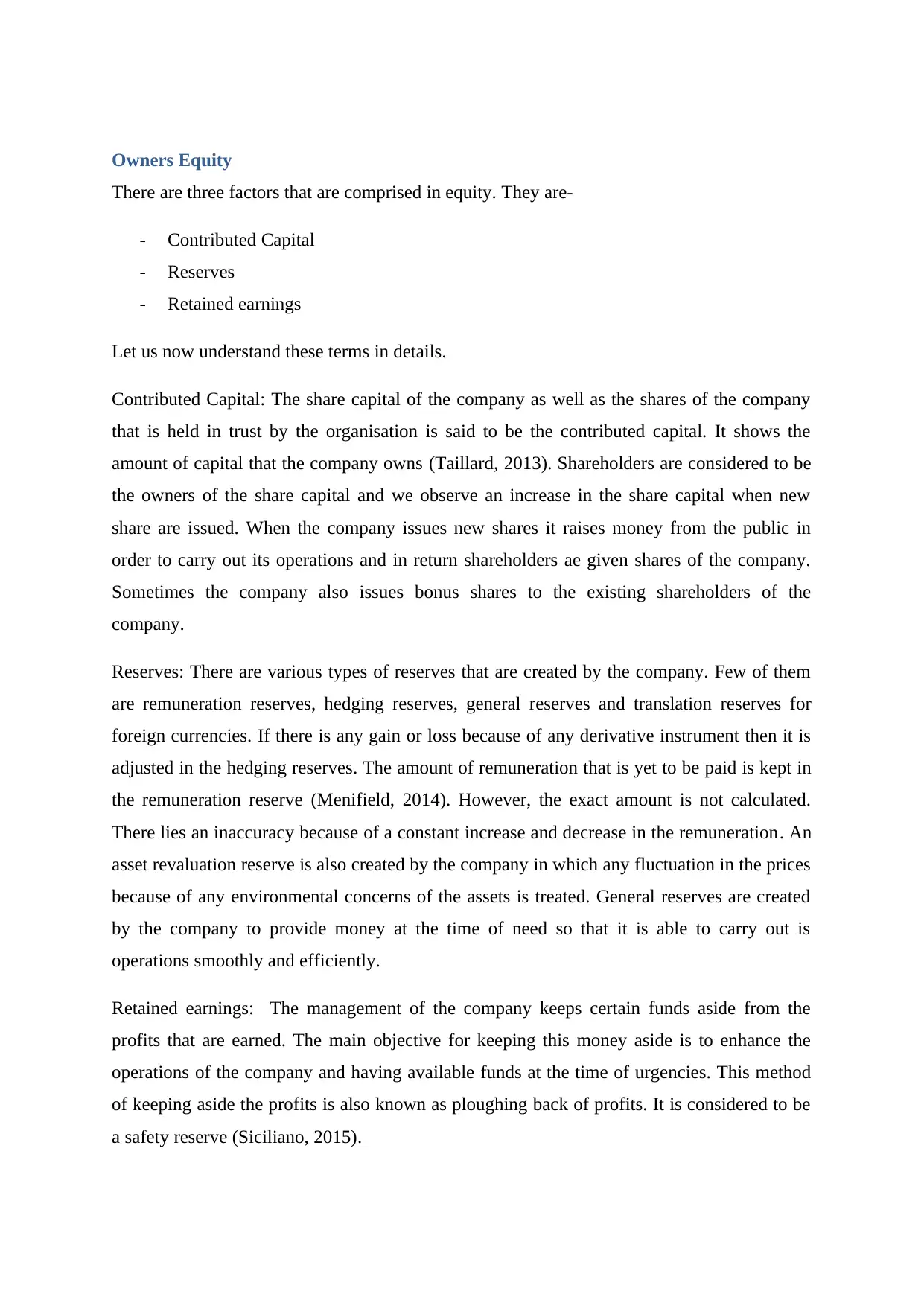
Owners Equity
There are three factors that are comprised in equity. They are-
- Contributed Capital
- Reserves
- Retained earnings
Let us now understand these terms in details.
Contributed Capital: The share capital of the company as well as the shares of the company
that is held in trust by the organisation is said to be the contributed capital. It shows the
amount of capital that the company owns (Taillard, 2013). Shareholders are considered to be
the owners of the share capital and we observe an increase in the share capital when new
share are issued. When the company issues new shares it raises money from the public in
order to carry out its operations and in return shareholders ae given shares of the company.
Sometimes the company also issues bonus shares to the existing shareholders of the
company.
Reserves: There are various types of reserves that are created by the company. Few of them
are remuneration reserves, hedging reserves, general reserves and translation reserves for
foreign currencies. If there is any gain or loss because of any derivative instrument then it is
adjusted in the hedging reserves. The amount of remuneration that is yet to be paid is kept in
the remuneration reserve (Menifield, 2014). However, the exact amount is not calculated.
There lies an inaccuracy because of a constant increase and decrease in the remuneration. An
asset revaluation reserve is also created by the company in which any fluctuation in the prices
because of any environmental concerns of the assets is treated. General reserves are created
by the company to provide money at the time of need so that it is able to carry out is
operations smoothly and efficiently.
Retained earnings: The management of the company keeps certain funds aside from the
profits that are earned. The main objective for keeping this money aside is to enhance the
operations of the company and having available funds at the time of urgencies. This method
of keeping aside the profits is also known as ploughing back of profits. It is considered to be
a safety reserve (Siciliano, 2015).
There are three factors that are comprised in equity. They are-
- Contributed Capital
- Reserves
- Retained earnings
Let us now understand these terms in details.
Contributed Capital: The share capital of the company as well as the shares of the company
that is held in trust by the organisation is said to be the contributed capital. It shows the
amount of capital that the company owns (Taillard, 2013). Shareholders are considered to be
the owners of the share capital and we observe an increase in the share capital when new
share are issued. When the company issues new shares it raises money from the public in
order to carry out its operations and in return shareholders ae given shares of the company.
Sometimes the company also issues bonus shares to the existing shareholders of the
company.
Reserves: There are various types of reserves that are created by the company. Few of them
are remuneration reserves, hedging reserves, general reserves and translation reserves for
foreign currencies. If there is any gain or loss because of any derivative instrument then it is
adjusted in the hedging reserves. The amount of remuneration that is yet to be paid is kept in
the remuneration reserve (Menifield, 2014). However, the exact amount is not calculated.
There lies an inaccuracy because of a constant increase and decrease in the remuneration. An
asset revaluation reserve is also created by the company in which any fluctuation in the prices
because of any environmental concerns of the assets is treated. General reserves are created
by the company to provide money at the time of need so that it is able to carry out is
operations smoothly and efficiently.
Retained earnings: The management of the company keeps certain funds aside from the
profits that are earned. The main objective for keeping this money aside is to enhance the
operations of the company and having available funds at the time of urgencies. This method
of keeping aside the profits is also known as ploughing back of profits. It is considered to be
a safety reserve (Siciliano, 2015).
⊘ This is a preview!⊘
Do you want full access?
Subscribe today to unlock all pages.

Trusted by 1+ million students worldwide
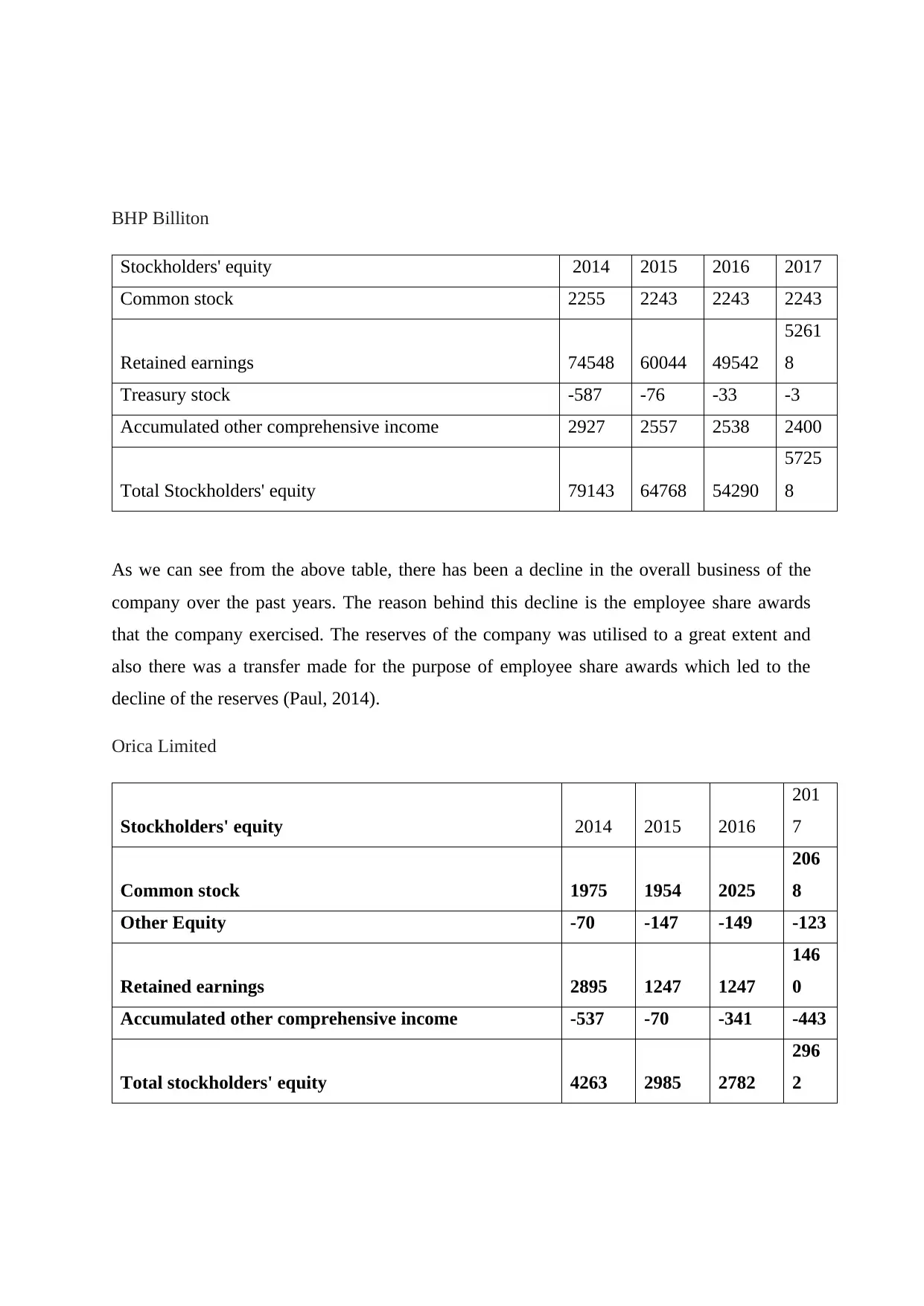
BHP Billiton
Stockholders' equity 2014 2015 2016 2017
Common stock 2255 2243 2243 2243
Retained earnings 74548 60044 49542
5261
8
Treasury stock -587 -76 -33 -3
Accumulated other comprehensive income 2927 2557 2538 2400
Total Stockholders' equity 79143 64768 54290
5725
8
As we can see from the above table, there has been a decline in the overall business of the
company over the past years. The reason behind this decline is the employee share awards
that the company exercised. The reserves of the company was utilised to a great extent and
also there was a transfer made for the purpose of employee share awards which led to the
decline of the reserves (Paul, 2014).
Orica Limited
Stockholders' equity 2014 2015 2016
201
7
Common stock 1975 1954 2025
206
8
Other Equity -70 -147 -149 -123
Retained earnings 2895 1247 1247
146
0
Accumulated other comprehensive income -537 -70 -341 -443
Total stockholders' equity 4263 2985 2782
296
2
Stockholders' equity 2014 2015 2016 2017
Common stock 2255 2243 2243 2243
Retained earnings 74548 60044 49542
5261
8
Treasury stock -587 -76 -33 -3
Accumulated other comprehensive income 2927 2557 2538 2400
Total Stockholders' equity 79143 64768 54290
5725
8
As we can see from the above table, there has been a decline in the overall business of the
company over the past years. The reason behind this decline is the employee share awards
that the company exercised. The reserves of the company was utilised to a great extent and
also there was a transfer made for the purpose of employee share awards which led to the
decline of the reserves (Paul, 2014).
Orica Limited
Stockholders' equity 2014 2015 2016
201
7
Common stock 1975 1954 2025
206
8
Other Equity -70 -147 -149 -123
Retained earnings 2895 1247 1247
146
0
Accumulated other comprehensive income -537 -70 -341 -443
Total stockholders' equity 4263 2985 2782
296
2
Paraphrase This Document
Need a fresh take? Get an instant paraphrase of this document with our AI Paraphraser
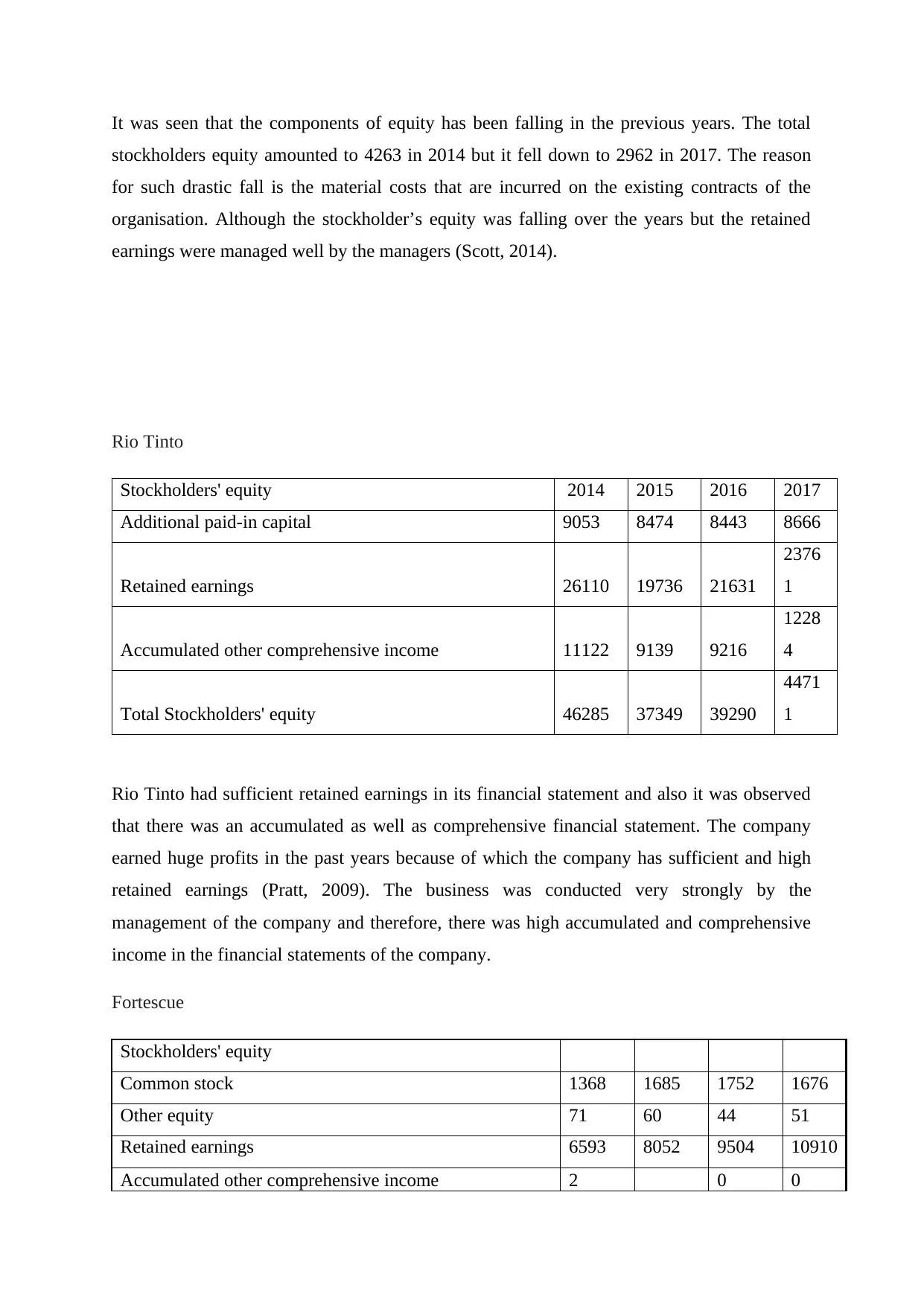
It was seen that the components of equity has been falling in the previous years. The total
stockholders equity amounted to 4263 in 2014 but it fell down to 2962 in 2017. The reason
for such drastic fall is the material costs that are incurred on the existing contracts of the
organisation. Although the stockholder’s equity was falling over the years but the retained
earnings were managed well by the managers (Scott, 2014).
Rio Tinto
Stockholders' equity 2014 2015 2016 2017
Additional paid-in capital 9053 8474 8443 8666
Retained earnings 26110 19736 21631
2376
1
Accumulated other comprehensive income 11122 9139 9216
1228
4
Total Stockholders' equity 46285 37349 39290
4471
1
Rio Tinto had sufficient retained earnings in its financial statement and also it was observed
that there was an accumulated as well as comprehensive financial statement. The company
earned huge profits in the past years because of which the company has sufficient and high
retained earnings (Pratt, 2009). The business was conducted very strongly by the
management of the company and therefore, there was high accumulated and comprehensive
income in the financial statements of the company.
Fortescue
Stockholders' equity
Common stock 1368 1685 1752 1676
Other equity 71 60 44 51
Retained earnings 6593 8052 9504 10910
Accumulated other comprehensive income 2 0 0
stockholders equity amounted to 4263 in 2014 but it fell down to 2962 in 2017. The reason
for such drastic fall is the material costs that are incurred on the existing contracts of the
organisation. Although the stockholder’s equity was falling over the years but the retained
earnings were managed well by the managers (Scott, 2014).
Rio Tinto
Stockholders' equity 2014 2015 2016 2017
Additional paid-in capital 9053 8474 8443 8666
Retained earnings 26110 19736 21631
2376
1
Accumulated other comprehensive income 11122 9139 9216
1228
4
Total Stockholders' equity 46285 37349 39290
4471
1
Rio Tinto had sufficient retained earnings in its financial statement and also it was observed
that there was an accumulated as well as comprehensive financial statement. The company
earned huge profits in the past years because of which the company has sufficient and high
retained earnings (Pratt, 2009). The business was conducted very strongly by the
management of the company and therefore, there was high accumulated and comprehensive
income in the financial statements of the company.
Fortescue
Stockholders' equity
Common stock 1368 1685 1752 1676
Other equity 71 60 44 51
Retained earnings 6593 8052 9504 10910
Accumulated other comprehensive income 2 0 0
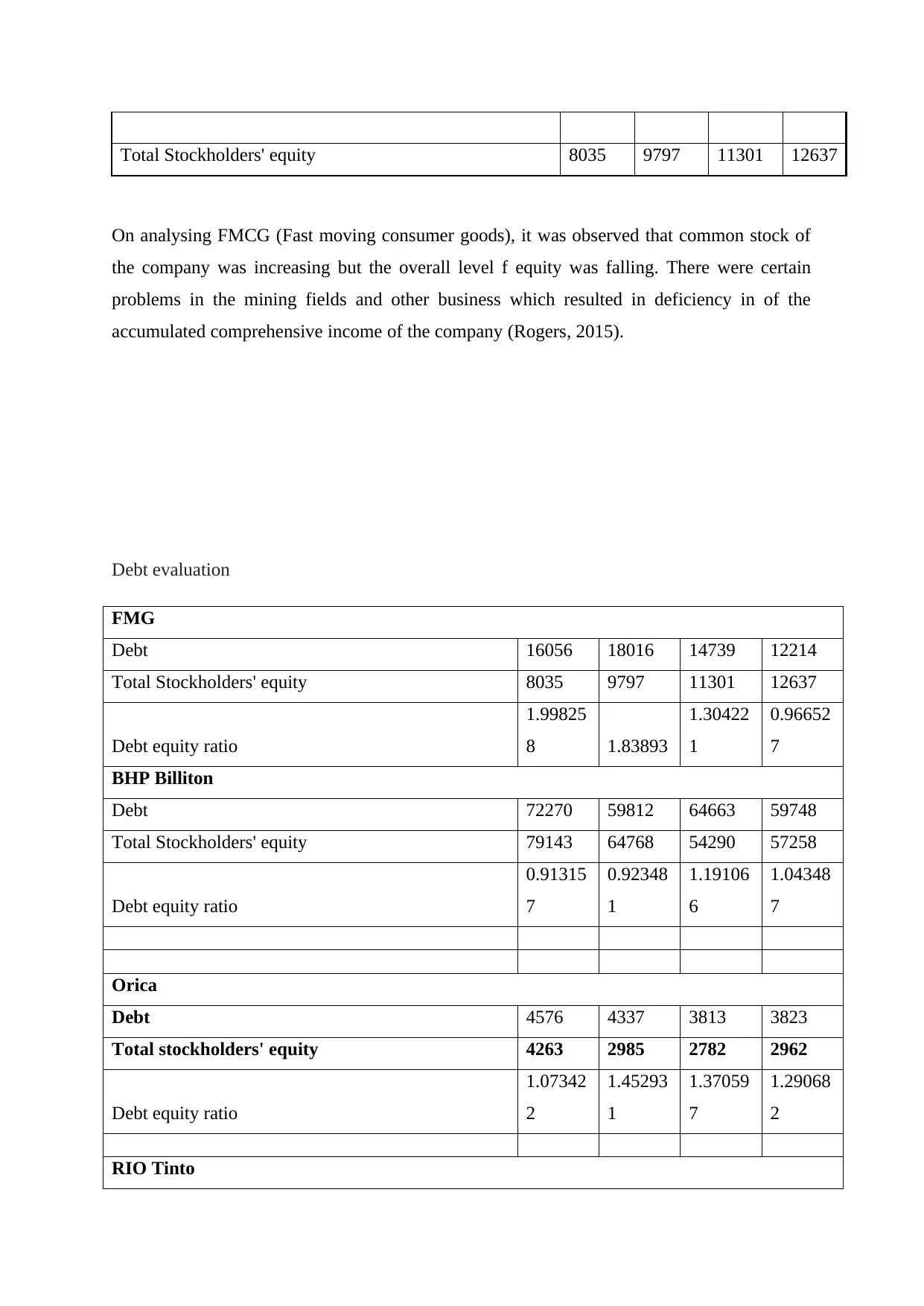
Total Stockholders' equity 8035 9797 11301 12637
On analysing FMCG (Fast moving consumer goods), it was observed that common stock of
the company was increasing but the overall level f equity was falling. There were certain
problems in the mining fields and other business which resulted in deficiency in of the
accumulated comprehensive income of the company (Rogers, 2015).
Debt evaluation
FMG
Debt 16056 18016 14739 12214
Total Stockholders' equity 8035 9797 11301 12637
Debt equity ratio
1.99825
8 1.83893
1.30422
1
0.96652
7
BHP Billiton
Debt 72270 59812 64663 59748
Total Stockholders' equity 79143 64768 54290 57258
Debt equity ratio
0.91315
7
0.92348
1
1.19106
6
1.04348
7
Orica
Debt 4576 4337 3813 3823
Total stockholders' equity 4263 2985 2782 2962
Debt equity ratio
1.07342
2
1.45293
1
1.37059
7
1.29068
2
RIO Tinto
On analysing FMCG (Fast moving consumer goods), it was observed that common stock of
the company was increasing but the overall level f equity was falling. There were certain
problems in the mining fields and other business which resulted in deficiency in of the
accumulated comprehensive income of the company (Rogers, 2015).
Debt evaluation
FMG
Debt 16056 18016 14739 12214
Total Stockholders' equity 8035 9797 11301 12637
Debt equity ratio
1.99825
8 1.83893
1.30422
1
0.96652
7
BHP Billiton
Debt 72270 59812 64663 59748
Total Stockholders' equity 79143 64768 54290 57258
Debt equity ratio
0.91315
7
0.92348
1
1.19106
6
1.04348
7
Orica
Debt 4576 4337 3813 3823
Total stockholders' equity 4263 2985 2782 2962
Debt equity ratio
1.07342
2
1.45293
1
1.37059
7
1.29068
2
RIO Tinto
⊘ This is a preview!⊘
Do you want full access?
Subscribe today to unlock all pages.

Trusted by 1+ million students worldwide
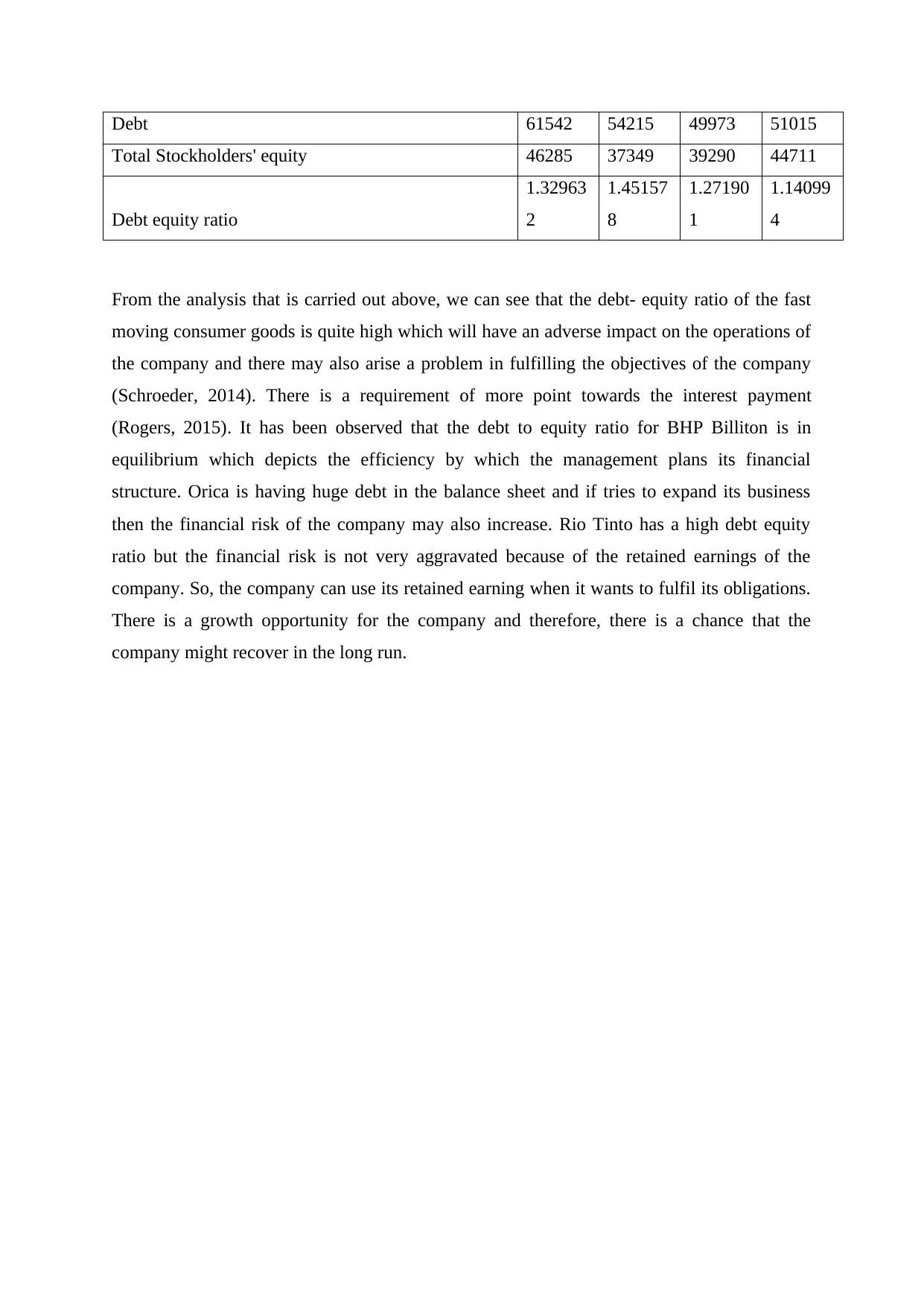
Debt 61542 54215 49973 51015
Total Stockholders' equity 46285 37349 39290 44711
Debt equity ratio
1.32963
2
1.45157
8
1.27190
1
1.14099
4
From the analysis that is carried out above, we can see that the debt- equity ratio of the fast
moving consumer goods is quite high which will have an adverse impact on the operations of
the company and there may also arise a problem in fulfilling the objectives of the company
(Schroeder, 2014). There is a requirement of more point towards the interest payment
(Rogers, 2015). It has been observed that the debt to equity ratio for BHP Billiton is in
equilibrium which depicts the efficiency by which the management plans its financial
structure. Orica is having huge debt in the balance sheet and if tries to expand its business
then the financial risk of the company may also increase. Rio Tinto has a high debt equity
ratio but the financial risk is not very aggravated because of the retained earnings of the
company. So, the company can use its retained earning when it wants to fulfil its obligations.
There is a growth opportunity for the company and therefore, there is a chance that the
company might recover in the long run.
Total Stockholders' equity 46285 37349 39290 44711
Debt equity ratio
1.32963
2
1.45157
8
1.27190
1
1.14099
4
From the analysis that is carried out above, we can see that the debt- equity ratio of the fast
moving consumer goods is quite high which will have an adverse impact on the operations of
the company and there may also arise a problem in fulfilling the objectives of the company
(Schroeder, 2014). There is a requirement of more point towards the interest payment
(Rogers, 2015). It has been observed that the debt to equity ratio for BHP Billiton is in
equilibrium which depicts the efficiency by which the management plans its financial
structure. Orica is having huge debt in the balance sheet and if tries to expand its business
then the financial risk of the company may also increase. Rio Tinto has a high debt equity
ratio but the financial risk is not very aggravated because of the retained earnings of the
company. So, the company can use its retained earning when it wants to fulfil its obligations.
There is a growth opportunity for the company and therefore, there is a chance that the
company might recover in the long run.
Paraphrase This Document
Need a fresh take? Get an instant paraphrase of this document with our AI Paraphraser
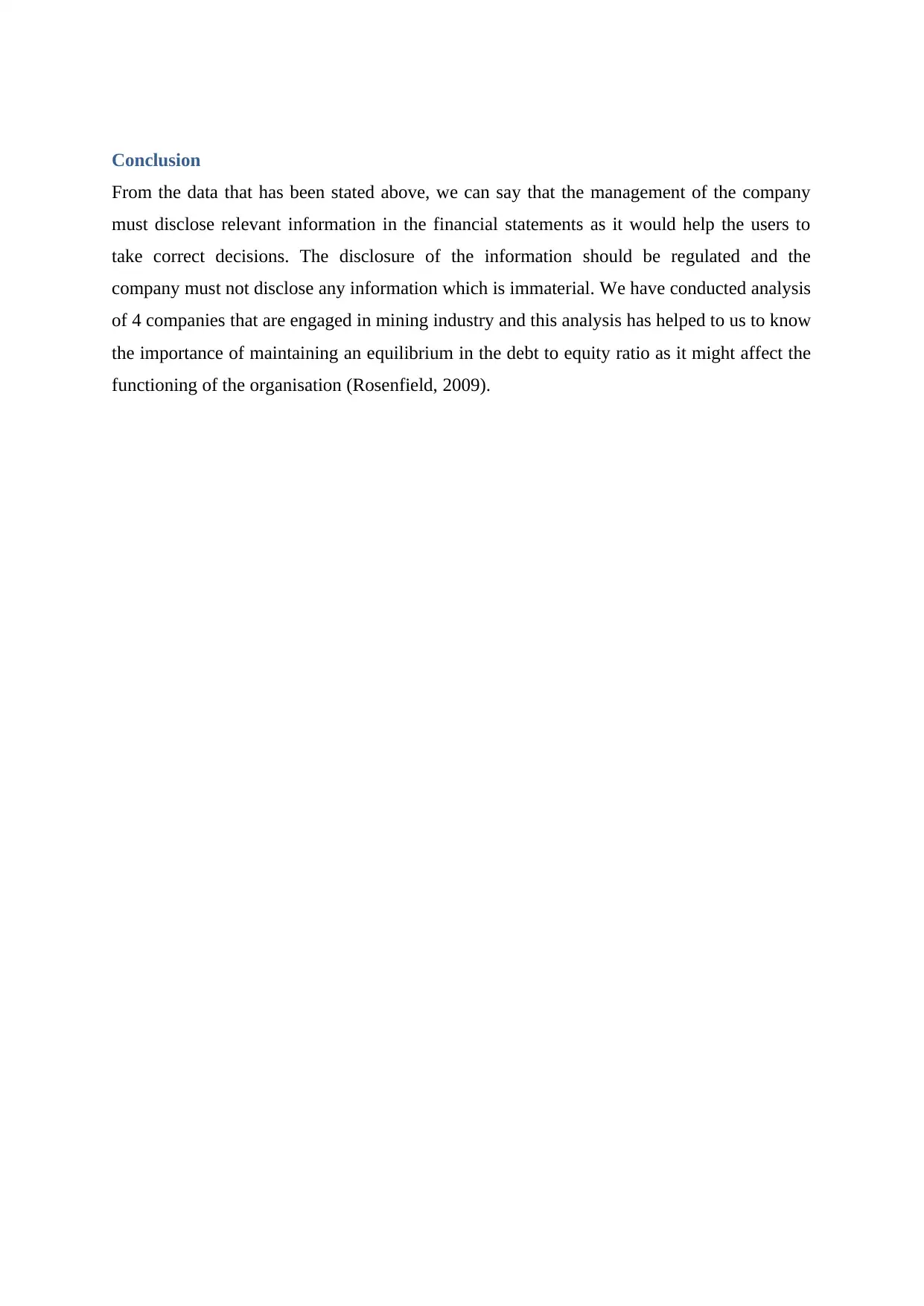
Conclusion
From the data that has been stated above, we can say that the management of the company
must disclose relevant information in the financial statements as it would help the users to
take correct decisions. The disclosure of the information should be regulated and the
company must not disclose any information which is immaterial. We have conducted analysis
of 4 companies that are engaged in mining industry and this analysis has helped to us to know
the importance of maintaining an equilibrium in the debt to equity ratio as it might affect the
functioning of the organisation (Rosenfield, 2009).
From the data that has been stated above, we can say that the management of the company
must disclose relevant information in the financial statements as it would help the users to
take correct decisions. The disclosure of the information should be regulated and the
company must not disclose any information which is immaterial. We have conducted analysis
of 4 companies that are engaged in mining industry and this analysis has helped to us to know
the importance of maintaining an equilibrium in the debt to equity ratio as it might affect the
functioning of the organisation (Rosenfield, 2009).
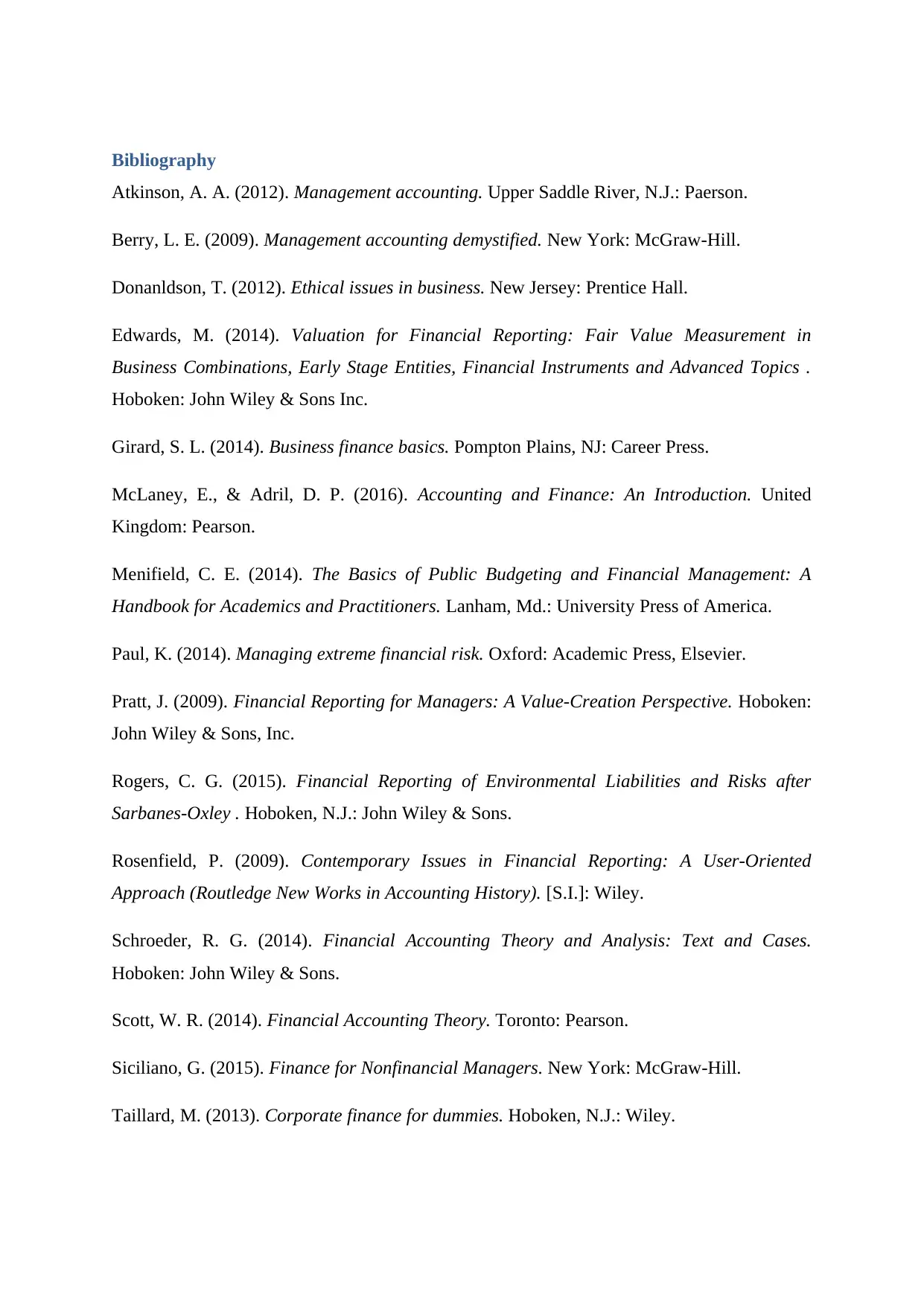
Bibliography
Atkinson, A. A. (2012). Management accounting. Upper Saddle River, N.J.: Paerson.
Berry, L. E. (2009). Management accounting demystified. New York: McGraw-Hill.
Donanldson, T. (2012). Ethical issues in business. New Jersey: Prentice Hall.
Edwards, M. (2014). Valuation for Financial Reporting: Fair Value Measurement in
Business Combinations, Early Stage Entities, Financial Instruments and Advanced Topics .
Hoboken: John Wiley & Sons Inc.
Girard, S. L. (2014). Business finance basics. Pompton Plains, NJ: Career Press.
McLaney, E., & Adril, D. P. (2016). Accounting and Finance: An Introduction. United
Kingdom: Pearson.
Menifield, C. E. (2014). The Basics of Public Budgeting and Financial Management: A
Handbook for Academics and Practitioners. Lanham, Md.: University Press of America.
Paul, K. (2014). Managing extreme financial risk. Oxford: Academic Press, Elsevier.
Pratt, J. (2009). Financial Reporting for Managers: A Value-Creation Perspective. Hoboken:
John Wiley & Sons, Inc.
Rogers, C. G. (2015). Financial Reporting of Environmental Liabilities and Risks after
Sarbanes-Oxley . Hoboken, N.J.: John Wiley & Sons.
Rosenfield, P. (2009). Contemporary Issues in Financial Reporting: A User-Oriented
Approach (Routledge New Works in Accounting History). [S.I.]: Wiley.
Schroeder, R. G. (2014). Financial Accounting Theory and Analysis: Text and Cases.
Hoboken: John Wiley & Sons.
Scott, W. R. (2014). Financial Accounting Theory. Toronto: Pearson.
Siciliano, G. (2015). Finance for Nonfinancial Managers. New York: McGraw-Hill.
Taillard, M. (2013). Corporate finance for dummies. Hoboken, N.J.: Wiley.
Atkinson, A. A. (2012). Management accounting. Upper Saddle River, N.J.: Paerson.
Berry, L. E. (2009). Management accounting demystified. New York: McGraw-Hill.
Donanldson, T. (2012). Ethical issues in business. New Jersey: Prentice Hall.
Edwards, M. (2014). Valuation for Financial Reporting: Fair Value Measurement in
Business Combinations, Early Stage Entities, Financial Instruments and Advanced Topics .
Hoboken: John Wiley & Sons Inc.
Girard, S. L. (2014). Business finance basics. Pompton Plains, NJ: Career Press.
McLaney, E., & Adril, D. P. (2016). Accounting and Finance: An Introduction. United
Kingdom: Pearson.
Menifield, C. E. (2014). The Basics of Public Budgeting and Financial Management: A
Handbook for Academics and Practitioners. Lanham, Md.: University Press of America.
Paul, K. (2014). Managing extreme financial risk. Oxford: Academic Press, Elsevier.
Pratt, J. (2009). Financial Reporting for Managers: A Value-Creation Perspective. Hoboken:
John Wiley & Sons, Inc.
Rogers, C. G. (2015). Financial Reporting of Environmental Liabilities and Risks after
Sarbanes-Oxley . Hoboken, N.J.: John Wiley & Sons.
Rosenfield, P. (2009). Contemporary Issues in Financial Reporting: A User-Oriented
Approach (Routledge New Works in Accounting History). [S.I.]: Wiley.
Schroeder, R. G. (2014). Financial Accounting Theory and Analysis: Text and Cases.
Hoboken: John Wiley & Sons.
Scott, W. R. (2014). Financial Accounting Theory. Toronto: Pearson.
Siciliano, G. (2015). Finance for Nonfinancial Managers. New York: McGraw-Hill.
Taillard, M. (2013). Corporate finance for dummies. Hoboken, N.J.: Wiley.
⊘ This is a preview!⊘
Do you want full access?
Subscribe today to unlock all pages.

Trusted by 1+ million students worldwide
1 out of 13
Related Documents
Your All-in-One AI-Powered Toolkit for Academic Success.
+13062052269
info@desklib.com
Available 24*7 on WhatsApp / Email
![[object Object]](/_next/static/media/star-bottom.7253800d.svg)
Unlock your academic potential
Copyright © 2020–2025 A2Z Services. All Rights Reserved. Developed and managed by ZUCOL.


